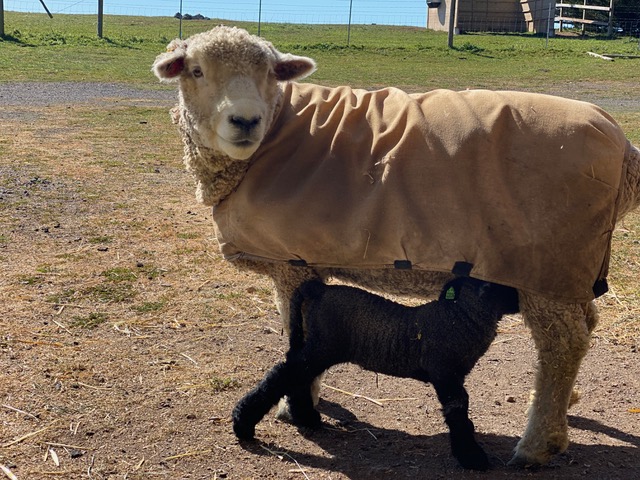Lambing is almost over, and I’ve hardly had a minute to write a blog post this year! We began on February 13, and have had no lambs born for the past two weeks, but we have 5 ewes holding out. We expect them to lamb in the next week or two. My friend Annie is coming to visit for a week and she was hoping for lambs to be born while she is here, so maybe they are waiting for her. And we have a Pacific Knitting Retreats 2-day knitting retreat here this weekend with Kristin Drysdale. Maybe they are waiting to add some excitement to the weekend with a lamb-storm. At any rate, we have been waiting for a while. It has given me a chance to get caught up on office-work and to connect with lamb customers. And to reflect on this lambing season.
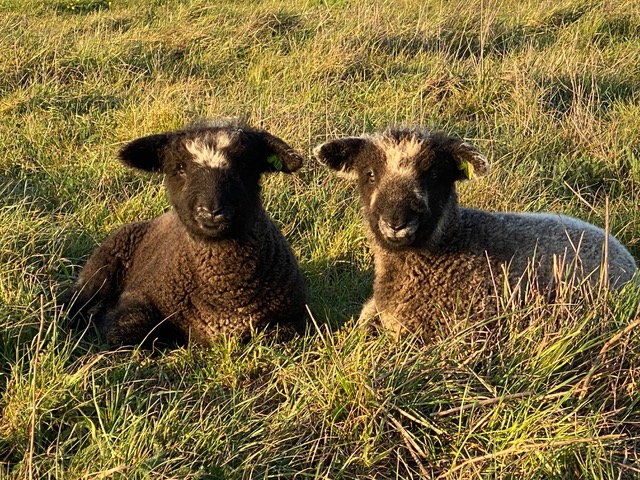
We have a pasture full of healthy lambs, and while we had a couple of still-births, we have not lost even one lamb after it was born.

Our first-time mothers are all doing well. Daisy, shown above with her daughter Hazel, is a cool and attentive mother. While Scarlett, shown below with her daughter, is a bit more on the hysterical side. She has a single lamb, like Daisy, but somehow is always misplacing her. When Scarlett is missing her lamb the whole ranch knows, because she charges back and forth through the flock, scattering ewes and lambs everywhere and bleating loudly and hysterically. If she were a human, she would be waving her arms around and screaming, with her hair flying in all directions. It would be funny if it weren’t so painful to watch her panic. Then suddenly she hears a familiar “baa,” barely audible over her shrieking, is reunited with her lamb, and all quiets down.
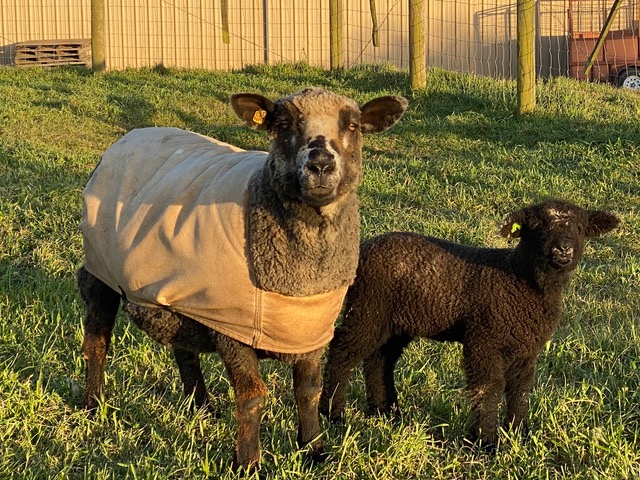
But the big story this season has been Romney triplets. Everyone has been having them. Swiss Miss, one of our older Romney ewes, started the trend by carrying triplets, but unfortunately the first one was dead in utero. Nevertheless she was left with two healthy boys that she is raising well.
When our ewes have triplets, we try to train the lambs to drink from a bottle when they are still in the jug with their mother, so if one of them starts getting outcompeted as they begin to grow and demand more milk from their mother, we can easily supplement them in the pasture. This approach lets them stay with their mothers and get all the benefits of that relationship, while still being assured of the nutrition they need.
It doesn’t always work. Celeste, our oldest Romney ewe at 10 years old, had triplets and is raising all three on her own, with none accepting bottle supplementation. They are growing a bit more slowly than the other lambs, but nevertheless they are steadily gaining, and doing fine.
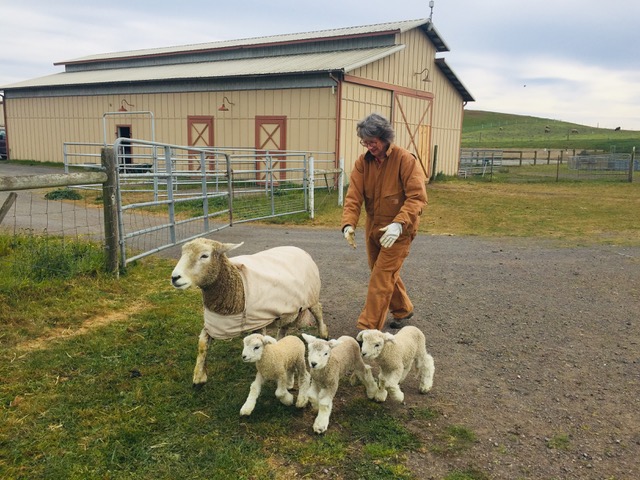

After Celeste, it seemed all of the Romneys had to follow the trend. Gladys had triplets, and loved all three a lot, but we got her boy to drink from a bottle. We marked him with a star so we could find him easily in the pasture, but there is no need to search for him now, as he comes running for his bottle.
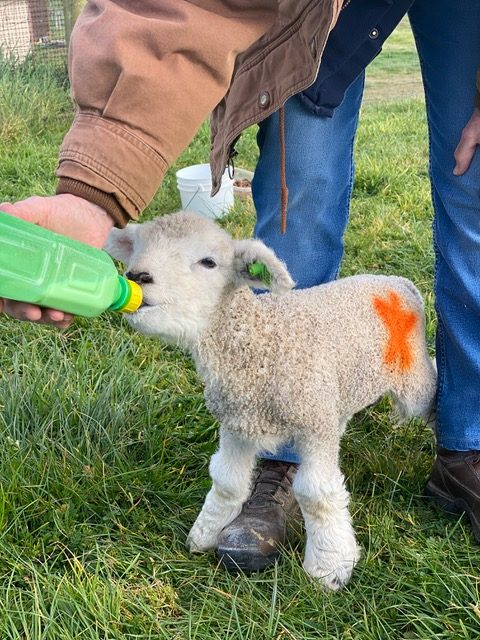
Gladys’s sister Pearl had triplets as well. Pearl and her family are just as independent as Celeste and hers. No bottles for them. And in Pearl’s case all the lambs are growing phenomenally. Maybe she would have made a good dairy ewe!
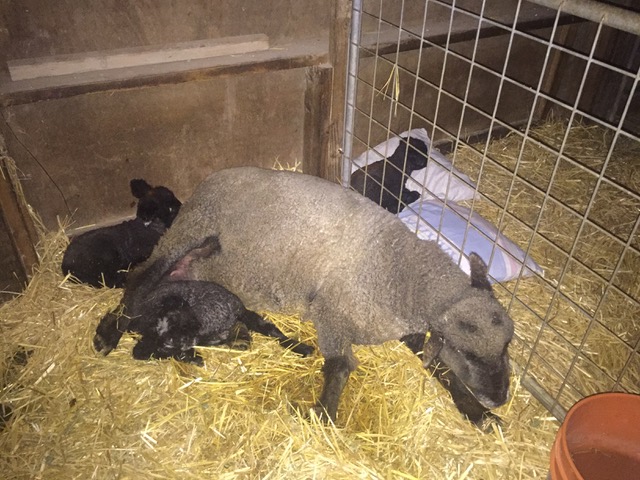
Then there was Scout. We love this Romney ewe and she is a trooper, and a very wise and curious ewe. She was very heavy for days before lambing. I was sure she had triplets, and worried that they were taking a lot out of her in her final days of pregnancy. Finally she lambed, on a Sunday morning, two weeks ago yesterday. Lolo found her in the barn with one lamb at 5 am, waited with her for nearly two hours, and then decided he needed to go out and feed. He came back from feeding and found her with a second. Then he left again to finish his chores, and she popped out a third, just before I arrived in the barn with my guest, Karin. We were so happy for Scout! But by the next morning we observed an unfortunate behavior, but one that has been selected for in sheep. If a ewe has twins or triplets and not enough milk, all the lambs may starve. So it is not uncommon for a ewe with multiple lambs to reject one. Without assistance, that lamb would die, but the others would live and carry on her genes, making this an adaptive trait that has been naturally selected for. By Monday morning, Scout had decide she hated her boy. She was brutally bashing him against the wall of the barn. It is such disturbing behavior to witness, even though it is adaptive from the perspective of sheep survival. But being conscientious shepherds, we of course intervened. We locked Scout in a “grafting stanchion,” a contraption that holds her head so she can’t turn around and bash her lamb. That let all the lambs, including the boy, get their fill of nourishing colostrum from their mother, laced with antibodies that will give them life-saving passive immunity to the diseases that their mothers have been immunized against.
Once little boy had enough colostrum, we settled him in the neighboring jug, where he was close to his family, but safe from his mother’s aggression.
Sometimes it is difficult not to get angry at a ewe for behavior like Scout’s, but she is just listening to her instincts and doing what nature tells her is best.
I had several emails from people who wanted a bottle lamb, and soon Scout’s boy was named “Banks,” and settled at Feather Flower Farm in Sebastopol where he will be a companion to a lonely and sweet wether who recently lost his companion.
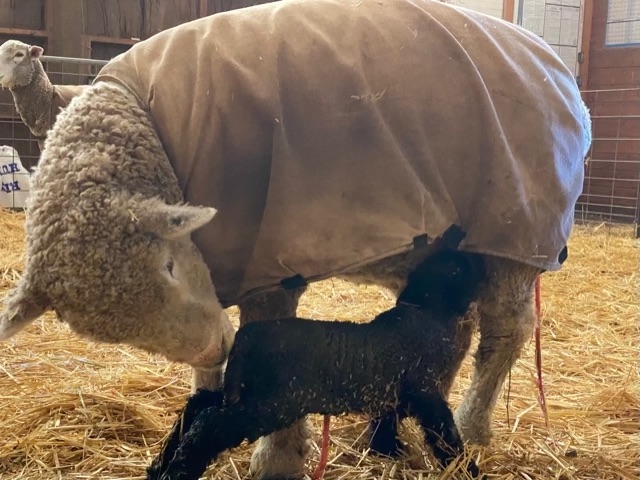
At the other side of the fertility spectrum from our prolific triplet-bearing Romneys, is Thelma Lou. We didn’t breed her as a lamb. The next year we bred her…but she didn’t get pregnant. The next year, same thing. At ultrasound day, Dr Dotti said “open,” and I said “same as last year.” He said “cull her.” I said, “no! she has the finest Romney fleece in my flock!” So we kept Thelma Lou, and continued to enjoy her beautiful fleeces. Then this year, Dr Dotti found her pregnant, and indeed she was! At four years old, Thelma Lou had her first lamb, a sweet boy who she loves very much. She brings to her motherhood a certain wisdom that later-life mothers can have. As if she has been preparing for this for a long time. And is enjoying each moment and taking it all calmly in stride.
And so it goes, each ewe an individual, and each mother-lamb relationship unique as well. We love them all.
